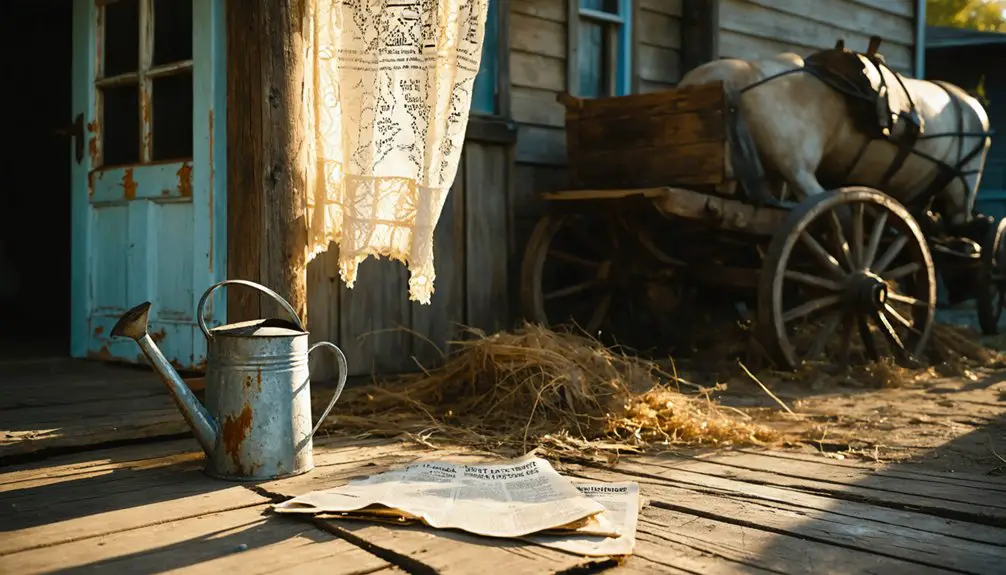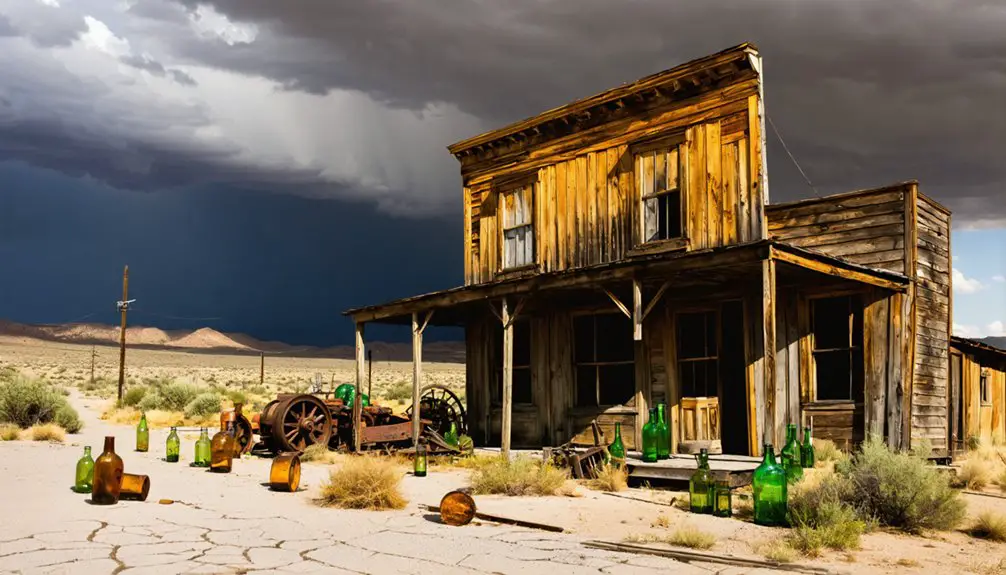You’ll find Alazon among Nevada’s ghost towns, a former mining settlement that thrived during the mineral boom era near the Comstock Lode region. The town generated $2 million at its peak through gold and silver extraction, with miners earning high wages working 12-hour shifts. Water challenges and the 1893 silver market crash led to its abandonment, leaving behind scattered foundations, rusted equipment, and preserved timber remains that tell a complex story of frontier ambition.
Key Takeaways
- Alazon was a gold and silver mining settlement in Nevada’s Comstock Lode region that flourished during the state’s mineral boom era.
- The town achieved peak production of $2 million through gold extraction from quartz veins using cyanide processing methods.
- Economic decline followed the 1893 silver market crash, leading to mine closures and eventual abandonment of the settlement.
- Workers faced challenging 12-hour mining shifts in hazardous conditions while maintaining vibrant social activities in saloons and dance halls.
- Today, only scattered building foundations, rusted mining equipment, and timber remains mark the location of this former boomtown.
The Rise of a Mining Frontier
As prospectors discovered promising mineral deposits in Nevada’s Comstock Lode region, Alazon emerged as a vibrant mining settlement during the state’s mineral boom era.
Nevada’s once-thriving Alazon arose from mineral discoveries in the Comstock region, joining the state’s mining boom settlements.
You’ll find that early exploration centered on gold and silver deposits, with pioneering miners using basic tools and placer mining techniques. News of discoveries quickly attracted mining investment and speculators to the area, leading to rapid claim-staking and community development.
The town’s growth demanded immediate infrastructure, including ore processing facilities and transportation networks. Miners could earn among highest wages, with salaries comparable to modern-day mining jobs that average $95,000 annually.
You’d have seen a diverse workforce of miners, engineers, and skilled craftsmen arriving from across the country and abroad, bringing their expertise to the frontier.
The settlement’s layout naturally evolved around the mining operations, with residential areas and commercial zones positioned strategically near the shafts and mills that drove Alazon’s economy.
Life in the Desert Boomtown
You’d find daily life in Alazon centered around grueling 12-hour mining shifts, where men descended into hazardous shafts while merchants and craftsmen kept the town’s basic services running.
After dark, you could join other residents at the saloon for gambling and socializing, or attend local dances when organized by the community.
Living in the harsh desert environment meant constantly battling extreme heat, water scarcity, and irregular food supplies, while dealing with the psychological toll of isolation.
Daily Mining Camp Routines
Life in the desert boomtown of Alazon revolved around three critical daily routines: mining operations, resource management, and basic survival.
You’d start your day at dawn, quickly consuming a breakfast of beans and hardtack before heading to the mines. Mining safety protocols required equipment inspections and tunnel timbering before you’d begin drilling and blasting. Like in Bullfrog and Beatty, many miners worked tirelessly in hazardous conditions.
Worker health suffered from the constant exposure to dust and toxic gases underground during 8-12 hour shifts. Supply wagons brought essential tools and explosives daily, while blacksmiths kept equipment operational.
You’d rely on carefully rationed water hauled from distant springs. After grueling shifts, you’d return to basic accommodations where communal washing facilities offered limited relief from the desert’s harsh conditions.
Camp managers maintained strict schedules while security personnel preserved order in the bustling boomtown.
Social Life After Dark
When darkness fell over Alazon, the desert boomtown transformed from a bustling worksite into a vibrant social scene. You’d find miners, merchants, and families gathering in saloons where live music and card games lasted into the early hours.
These nighttime gatherings served as more than entertainment – they fostered essential social bonds and business connections.
In the dance halls and theaters, you could enjoy performances by traveling acts or local musicians. The town’s limited law enforcement meant you’d need to stay alert, as brawls and occasional shootouts were real risks.
But the rewards of nightlife were substantial: significant networking opportunities, chances to strike business deals, and a welcome escape from the harsh realities of desert mining life.
Religious meetings and seasonal celebrations added cultural depth to Alazon’s after-dark activities.
Desert Survival Challenges
Despite the allure of striking it rich, surviving in Alazon meant battling the desert’s relentless challenges. You’d face scorching days above 100°F and dangerous temperature plunges at night, making desert navigation techniques essential for your safety.
Without natural water sources nearby, you’d need emergency water sourcing skills and strict rationing to survive. Miners had to pipe water from Dead Horse Creek, demonstrating the extreme measures needed to sustain life in the harsh environment.
The harsh environment didn’t stop there. You’d struggle with makeshift shelters that offered little protection from dust storms and extreme temperatures.
Food preservation became a daily challenge, as you’d rely heavily on dried and salted provisions shipped from distant locations.
Health risks lurked everywhere – from venomous creatures to constant respiratory issues from dust exposure. Living in Alazon required vigilance against heatstroke, dehydration, and the ever-present threat of medical emergencies with limited access to care.
Mining Methods and Operations
You’ll find that Alazon’s mining operations centered on extracting gold from quartz veins using a massive cyanide processing plant that chemically separated the precious metal from surrounding minerals.
The miners relied heavily on timber supports and hand-forged bolts to reinforce the underground tunnels as they followed the gold-bearing veins deeper into the mountain.
Getting adequate water supplies to the remote desert location proved challenging for both the mining operations and the growing population of workers.
Equipment and Processing Methods
The mining operations at Alazon centered around a massive cyanide plant designed to extract gold from rich quartz veins. The facility’s cyanide efficiency revolutionized gold processing, allowing you to achieve yields that weren’t possible with older methods.
Advanced quartz extraction techniques, powered by electricity from distant Bishop, helped reveal nearly $2 million at peak production.
Key aspects of the operation included:
- Square-headed bolts driven by hammer, showing the hands-on assembly methods
- Elaborate timber framing with precise notching to handle mining stresses
- Long-distance power lines stretched across the landscape to energize the equipment
- Chemical processing that bonded cyanide with gold to separate it from other minerals
The equipment setup demonstrated how you could overcome logistical challenges through strategic sourcing and innovative processing methods.
Water Supply Challenges
While Alazon’s mining operations required substantial water resources, the arid Nevada climate posed significant supply challenges. You’d find water conservation measures were essential, as miners relied on wells, springs, and limited surface water collection from sources often miles away.
The scarcity forced operations to adapt, favoring dry extraction methods and implementing storage tanks to maximize efficiency. Pioneering engineer Hugh Shamberger documented the critical role of water systems in Nevada’s mining settlements.
Water transportation proved costly and difficult, requiring wagon delivery and maintenance of basic infrastructure like storage tanks and cisterns.
Mining sustainability suffered as water shortages restricted processing throughput and operational scale. You’d notice the impacts extended beyond production – workers faced reduced comfort and hygiene, while disputes over water rights became common.
These persistent water challenges ultimately contributed to Alazon’s decline and eventual abandonment as a mining settlement.
Daily Life and Social Scene

Life in Alazon centered around several vibrant social venues that served as community hubs during the town’s peak mining period in the early 1900s.
You’d find social gatherings happening regularly in the town’s saloons, ballrooms, and dance halls, fostering community cohesion despite the harsh mining town conditions. These venues weren’t just for entertainment – they were crucial information exchange centers where you could stay connected with local happenings.
Key aspects of Alazon’s social scene included:
Life in Alazon revolved around dynamic social venues where miners met, communities danced, and business thrived beneath electric lights.
- Community dances documented in historical photographs
- Saloons serving as primary meeting spots for miners
- Real estate transactions reaching $88,000, showing economic dynamism
- Infrastructure supporting both residential life and entertainment venues, including concrete structures and power lines to Bishop
The Path to Abandonment
Despite its earlier prosperity, Alazon’s decline began with a perfect storm of economic challenges in the late 19th century. The silver market crash of 1893, combined with depleting ore quality, crippled the town’s economic viability.
You’d have witnessed the mines closing one by one, leaving workers jobless and desperate for opportunities elsewhere. As younger residents fled to booming neighboring towns, Alazon’s community cohesion crumbled.
The town’s isolation, with its poor road infrastructure and limited railroad access, only accelerated its downfall. Essential services shuttered, and buildings fell into disrepair.
Environmental challenges, including water scarcity and harsh desert conditions, dealt the final blow. While nearby towns adapted by diversifying their economies and securing railroad connections, Alazon couldn’t overcome its mounting obstacles, leading to its eventual abandonment.
Modern-Day Remnants and Legacy

Today’s visitors to Alazon encounter scattered building foundations, rusted mining equipment, and fragments of cyanide processing facilities that mark this once-bustling settlement.
The historical significance of these remnants tells the story of early 20th-century mining innovation and economic prosperity, with the town once generating $2 million at its peak.
You’ll find these key features that define Alazon’s current state:
- Timber remains with distinctive notching and square bolts that showcase period construction methods
- Environmental impacts visible through mining-disturbed landscapes and tailing piles
- Preserved power line infrastructure that traces supply routes to Bishop
- Soil composition altered by industrial processes and chemical residues
While artifact preservation remains challenging due to harsh desert conditions and vandalism, Alazon’s legacy lives on through photographic records and archaeological documentation.
Frequently Asked Questions
Are There Any Reported Ghost Sightings or Paranormal Activities in Alazon?
You won’t find verified ghost encounters in Alazon. While hikers report shadowy figures and mysterious sounds, there’s no historical evidence or formal paranormal investigations to support supernatural claims in this area.
What Valuable Artifacts Have Been Discovered by Modern Explorers in Alazon?
You’ll find silver ore samples, abandoned mining equipment, steam engine parts, household items, and tools through modern exploration techniques. These artifacts hold significant historical value for understanding 19th-century mining operations.
Did Any Famous Outlaws or Historical Figures Visit Alazon?
You won’t find any confirmed outlaw legends or historical visits to Alazon in the records. Unlike other Nevada ghost towns, there’s no evidence of famous outlaws or notable figures ever stopping there.
Were There Any Major Disasters or Tragic Events in Alazon?
When the $2-3 million Montgomery-Shoshone mine failed in 1911, you’d have witnessed the town’s most tragic event: a devastating economic collapse that wiped out thousands of residents’ livelihoods.
What Native American Tribes Originally Inhabited the Area Before Mining Began?
You’ll find the Western Shoshone culture dominated this region, with their nomadic bands moving through the area. Southern Paiute tribes also influenced the territory, sharing resources and developing trade networks before mining began.
References
- https://projects.gbreports.com/nevada-mining-2022/introduction-to-nevada-mining
- https://en.wikipedia.org/wiki/List_of_ghost_towns_in_Nevada
- https://www.youtube.com/watch?v=ayDjmdCwRVc
- https://forgottennevada.org/sites/bib.html
- https://www.youtube.com/watch?v=E8LuAWW3C5s
- https://www.youtube.com/watch?v=c_K3YqnZ-ps
- https://www.youtube.com/watch?v=nPBwZzupRk4
- https://www.moon.com/travel/trip-ideas/ghost-town-rhyolite-death-valley/
- https://www.youtube.com/watch?v=GWfjpHpblVg
- https://americanindiancoc.org/native-american-tribes-the-indian-history-in-ely-nevada/



